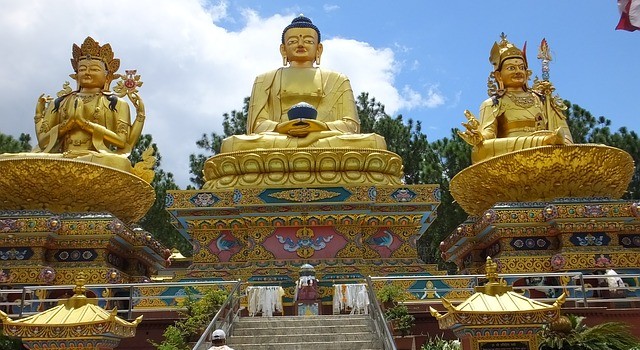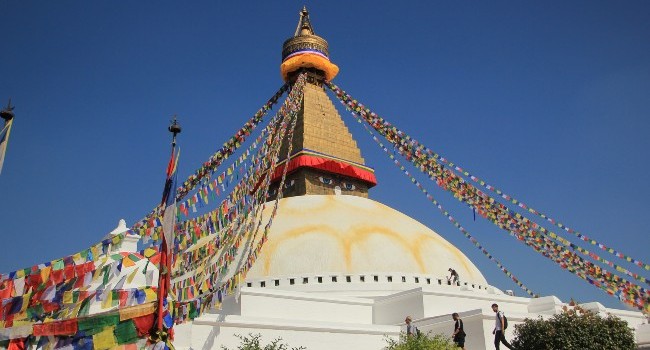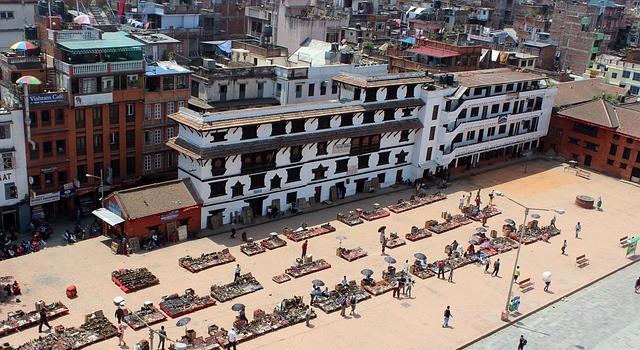Kathmandu Valley Sightseeing Day Tour is a short journey that allows you to discover the Kathmandu district’s antique temples and religious shrines. You will visit the top four UNESCO World Heritage Sites, including Swoyambhunath temple, Boudhanath Stupa, Pashupatinath Temple, and Kathmandu Durbar Square. The tours and sightseeing in Kathmandu valley take you into a mystical history where the past remains alive in the present, tradition tirelessly repeats itself into a culture that remains seeped into an ancient account created by the Kings of past generations, and religious doctrines strictly stay till this day.
 Buddha Statue at Swoyambhunath temple also called ‘Monkey Temple.’
Buddha Statue at Swoyambhunath temple also called ‘Monkey Temple.’
We begin today’s sightseeing tour with a visit to Swoyambhunath, also called Monkey Temple, a 2500-year-old site; it is said to be the Radiant Lotus of the valley mythology settled when Manjushri, the god of wisdom, drained the water. The Five Dhyani Buddha, attended by their consorts, are enshrined at the stupa’s base, then continue to tour into Boudhanath.
 Boudhanath Stupa in Kathmandu
Boudhanath Stupa in Kathmandu
The Boudhanath Stupa is the world’s largest Stupa and of Tibetan Buddhist Culture in Nepal. Antique shops where you can buy things of your preference relating to Buddhist religion such as Thankas, etc.
 Pashupatinath Temple Kathmandu
Pashupatinath Temple Kathmandu
After the Boudhanath, you will proceed to Pashupatinath Temple stands along the side of the Bagmati River. It is a sacred temple for Hindus. Pashupatinath temple is dedicated to Lord Shiva, one of the Hindu trinity and guardian deities. As you approach the cremation areas of the temple, you will witness the Hindu ritual of cremating a corpse. During the festival of Shiva Ratri, the temple is crowded with hundreds of thousands of devotees. Although, the new electric cremation machine is started working due to environmental causes.
 Kathmandu Durbar square, also called Basantapur Durbar Square
Kathmandu Durbar square, also called Basantapur Durbar Square
In the afternoon, you will visit Kathmandu Durbar Square; also known as Basantapur Durbar Square, including Hanuman Dhoka, the ancient royal residential quarter, Mahadev and Parvati Temple, Machhender Bahl – a holy place for the Buddhists and Hindus, Temple House of Kumari, the vestal virgin or the Living Goddess. Due to the devastating earthquake in April 2015, some temples were destroyed and impacted but are still worth visiting. After completing a day tour excursion, you will be dropped off at your reserved Hotel.
Some quick links;
Hassle-free is the word. If you plan to visit these countries? Anup at Himalayan Windows is the guy you need to see. Almost a year of planning and he was on top of things every single time. Any questions? He answers. Any suggestions? He answers. Better yet? You don’t need to plan anything. Have him plan it for you! He even booked us a fine dining restaurant in which my…
Payment: A deposit of 30% of the total tour cost is required to book the tour with Himalayan Windows (HW). The remaining balance is to be paid three days prior to the departure date. Payment can be made via Wire Transfer or Credit Card. All credit card payments are securely processed and a bank fee applies.
Cancellation: For cancellations more than 30 days before the Tour Start Date, there will be no cancellation fee. If the cancellation happens within 29-4 days prior to the Tour Start Date, a charge of 30% of the total invoice amount will be applied. Cancellations occurring within 3 days or less of the start date or in the case of a no-show, 100% of the total invoice amount will be charged. Learn more about Terms and Conditions.
Accommodation: Accommodation is typically provided in twin rooms in cities, though a single supplement can be requested for an additional fee. During peak season, it can be difficult to find single or twin rooms in the mountains, so our lodges usually offer dormitory-style accommodation. Our priority is always to provide clean and safe rooms for our guests.
Meals: Our packages in Bhutan include full board meals, with breakfast, lunch, and dinner included. For treks, all meals are provided, but you will need to pay extra for drinking water and snacks.
Nepal Visa: If you are planning a trip to Nepal, you must have a valid passport and Nepal Visa. Depending on your country of origin, you may need to obtain a Nepal Tourist Visa before your arrival. To be eligible, your passport should be valid for a minimum of six months from your Tour Start Date. If you are planning on traveling to multiple countries on your trip, make sure to get a multi-entries Nepal Visa.
Bhutan Visa Clearance: All visitors to Bhutan must have a valid Bhutan Visa Clearance before their trip. To obtain it, you must submit a color-scanned copy of your passport, which must be valid for at least 6 months from the start date of your tour. Your tour operator will send you a Visa Clearance prior to your departure, which you must present at the Druk Air/Bhutan Airlines counter during check-in. Once you arrive at Paro Airport, your passport will be stamped with the original visa.
Tibet Group Visa (TGV): All travelers from any nation intending to go to Tibet from Nepal must obtain a Tibet Group Visa (TGV) in Kathmandu with the help of a tour operator. To ensure the successful application of the TGV, you should plan to arrive in Kathmandu 3-4 working days before your travel date. If you are coming from China, you will not require a TGV; instead, you will need a Chinese Visa and Permit. To find out more about the process of entering Tibet, please look into the Tibet entry procedure.
Nepal & Bhutan: Visiting Nepal and Bhutan at the same time is ideal as they share a similar climate. From high mountains to low land sub-tropical plains and jungles, the two countries have similar weather. The best time to visit is from March to April (spring) and October to December (autumn and early winter). During these months, the air is clean and fresh with sunny skies. January and February are colder months, while June, July, and August (summer) are typically monsoon seasons.
Tibet: It is best to visit Tibet between April and October when the weather is warm and the skies are clear. However, from November to March, it is still possible to explore certain areas like Namtso, Everest Base Camp, and Mount Kailash, as long as the roads are not blocked by snow. Temperatures during this time may be quite cold.
HimalayanWindows strongly recommends that anyone planning to travel in the Himalayas purchase Travel Insurance. This policy will provide coverage in the case of medical emergencies, evacuation, theft, loss of belongings, and last-minute tour/ticket cancellations. Having this protection in place will help ensure that your trip is safe and enjoyable.
Frequently Asked Questions (FAQs) about Nepal Tour and Trekking Do I Need A Visa To Enter Nepal? Yes, all foreigners, Except Indians, need a Nepalese visa to enter Nepal. Most nationals can get an on-arrival visa at the TIA airport. However, it is advised to consult with your nearby Embassy or Consulate of Nepal. What do I need to get my visa? You need to have a valid passport, some… Read More »